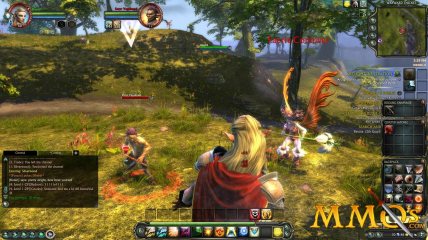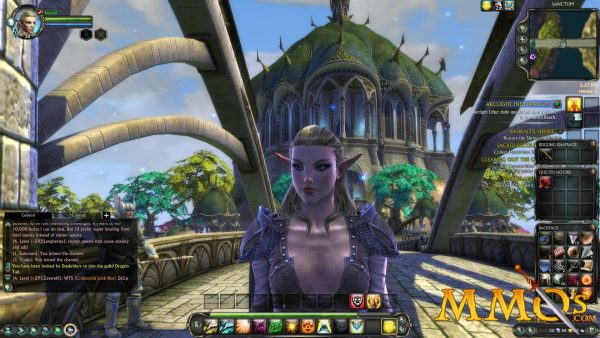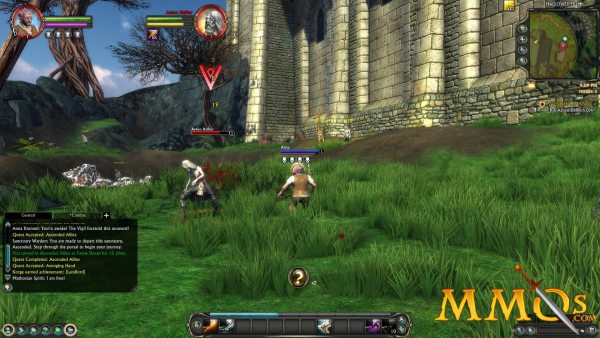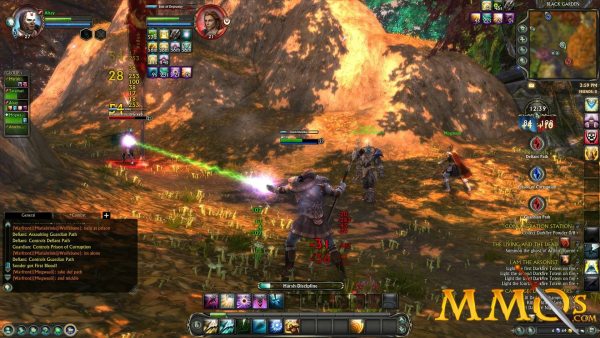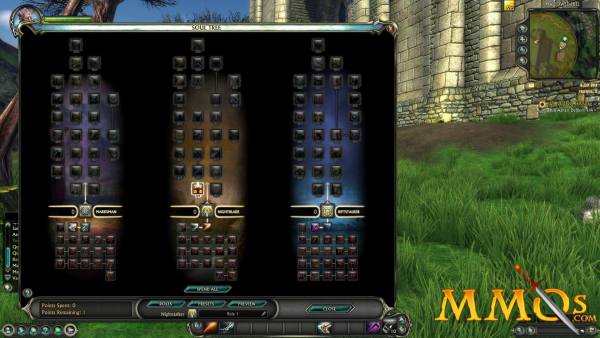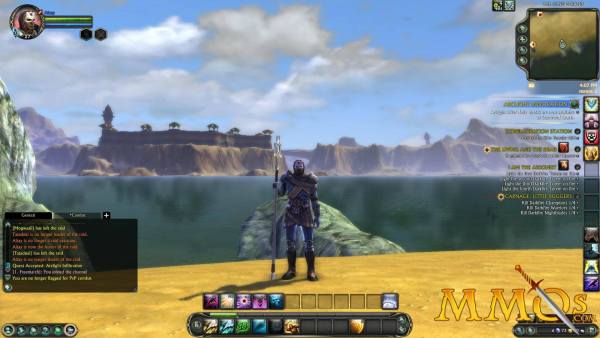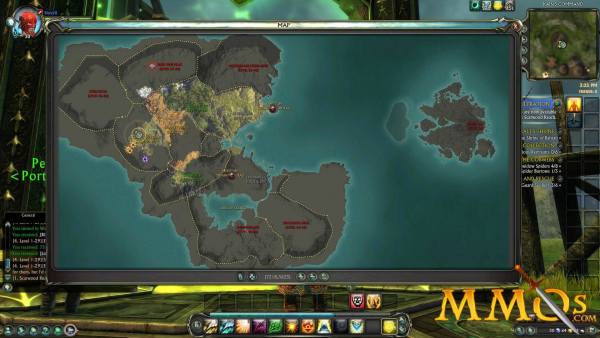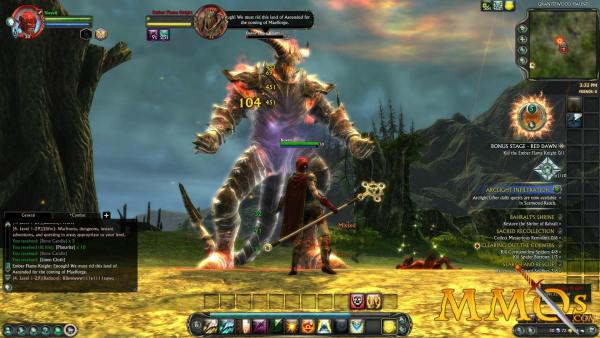Rift
Rift is a 3D fantasy MMORPG set in the expansive world of Telara. The game offers a unique and extensive class system, player housing, and dynamic zone-wide events. Rift is feature-rich and well-suited for traditional MMORPG fans looking for a truly epic world to explore.
| Publisher: Trion Worlds Playerbase: Low Type: F2P MMORPG Release Date: March 1, 2011 PvP: Duels / Battlegrounds / PvP Servers Pros: +Massive amount of content to play through. +Rifts create dynamic gameplay experiences. +Extensive class customization. +Balanced cash shop. Cons: -Limited race selection. -Only a few builds viable in late game. -Generic MMORPG combat, user interface, and questing features. |
Rift Overview
Set in the mythical world of Telara, where the six elemental planes of Air, Fire, Water, Earth, Life, and Death converge, Rift is a traditional high-fantasy MMORPG designed in the vein World of Warcraft. The gameplay, user-interface, and questing progression may feel similar, but Rift is no clone. The game offers a host of additional features, as well as some original concepts. Chief among these is the Ascended Soul class system. Rift offers four generic class callings, but each has ten souls or skill trees to chose from. Players select three of these souls at a time, allowing for many different combinations. Another key feature are Rifts, which are dynamically generated events that occur on many of the larger maps in the game. Players must band together to close these rifts by defeating monsters, which further progresses zone-wide events culminating into an open-world boss raid.
Rift Key Features:
- Dynamic Gameplay – play on large maps that generate Rifts, which players must close by working together.
- Massive Amount of Content – seriously, there is a ton of content available for players to slog through, it's pretty amazing.
- Great Character Creation – choose from many options for hairstyles, eye color, height, etc.
- Load Out – extensive customization options, along with two skill trees (one class-dependent, one character-dependent).
- No Money Necessary – truly an MMO that is free-to-play.
Rift Screenshots
no images were found
Rift Featured Video
Factions and Races:
- The Guardians – Dwarves, High Elves, Mathosian
- The Defiant – Bahmi, Eth, Kelari
Class Callings and Souls:
- Cleric – Cabalist, Defiler, Druid, Inquisitor, Justicar, Oracle, Purifier, Sentinel, Shaman, Warden
- Mage – Arbiter, Archon, Chloromancer, Dominator, Elementalist, Harbinger, Necromancer, Pyromancer, Stormcaller, Warlock
- Rogue – Assassin, Bard, Bladedancer, Marksman, Nightblade, Physician, Ranger, Riftstalker, Saboteur, Tactician
- Warrior – Beastmaster, Champion, Liberator, Paladin, Paragon, Reaver, Riftblade, Void Knight, Warlord, Tempest
- Primalist – Vulcanist, Berserker, Typhoon, Titan, Dervish, Preserver
Rift Review
By Toan Layne
Rift, formerly known as Rift: Planes of Telara, is a 3D fantasy MMORPG developed and published by Trion Worlds. It was released on March 1, 2011 in North America, and on March 11, 2011, in Europe. The game was originally released with a subscription-based model, but became free-to-play on June 12, 2013. There have been two expansions so far: Storm Legion (released on November 13, 2012) and Nightmare Tide (released on October 22, 2014).
The First Hour
Rift takes place in the world of Telara, the focal point between the elemental planes of Earth, Water, Fire, Air, Death, and Life. Each one of these planes is controlled by a dragon-deity. When Regulos, the Dragon of Extinction, set his ambitions on conquering Telara he united all the other dragons and started invading. Now dimensional rifts are opening all over the place and it is up to you, the Ascended, to defeat Regulos and rid Telara of his scourge forever.
Exciting, right? As Ascended, you can be one of two factions: the Guardians or the Defiant. The Guardians are pious followers of Vigil, the Supreme God of Telara, who helped defeat Regulos in the past. On the other hand, the Defiant do not follow the religion of Vigil, and instead focus their efforts on science and technology. The Guardian races are: the high elves, the Mathosians, and the dwarves, while the Defiant races are: the Eth, the Bahmi, and the Kelari.
The character creation process is fairly strong. You have quite a large amount of options when it comes to hair, hair color, facial features, and facial hair. On top of that, you also have sliders to tweak certain features such as the nose, mouth, height, and eyes. Creating your character’s face is done on a triangle slider, which gives you more control than choosing a preset face, but less control than having a slider for each facial feature. Customization lands somewhere in the middle, where presumably everyone can be satisfied.
During my first hour in the game, I was drawn into a world where the starting zone was filled with dragons flying in the sky and tentacles trying to constrict volcanoes. I don’t know about you, but that’s what I call a good starting zone. Controls are simple: WASD to move, numbers to cast spells, and mouse to look around. There is a good quest tracking system that shows you where you need to go on the minimap, and skills are learned automatically upon leveling. All of the standard, good stuff you expect to find in a modern MMORPG.
The Class System
The class system in Rift is very interesting and it’s based on souls. The Ascended absorb the souls of the great heroes of the past and gain their skills and power. Basically, souls are talent trees/classes. In the character creation screen, players will choose one of four callings: warrior, rogue, mage, and cleric. They will then go on to choose their first soul. There are 36 souls in total, and 9 per calling. Players can add, augment, and replace souls within their calling at will, being able to have active up to three souls at a time. Basically, players can create a unique class that fits their specific playstyle, and if they’re not happy with it, they can swap it out and try something new. Progression is done by spending points in these soul trees, which will unlock new abilities and passive traits. There are two ways you can spend points: you have Branch Advancement and Root Advancement. Branch Advancement means that you spend points into your souls, while Root Advancement represents points that can be spent on core attributes, which are the same for every character regardless of class.
Rifts
A big part of Rift is the rift system. Rifts will spawn throughout the world, and players have to team up and fight through waves of enemies, defeat a boss, then close the rift. There are six types of rifts, each based on which elemental plane they spawn from (Earth, Water, Fire, Air, Life, and Death), and five difficulty levels (Minor, Major, Expert, Raid, and Hunt). As of patch 1.51, Crafting Rifts have been implemented. These rifts drop crafting materials, enticing even more players to join in these events.
Some rifts can spawn Invaders, which will start to roam a zone in packs. If these Invaders take over a Wardstone, they will gain a foothold in the area and spawn more of their kin. If they are left unchecked even further, they can take over an entire zone and will start spawning epic bosses. Epic bosses take a long time and a large group of people to defeat. Players gain special tokens for closing rifts and these tokens can then be exchanged for rewards. I don’t know about you, but I love spontaneous events, whether it’s open world mass PvP, or players teaming up to defeat a raid boss. Nothing brings people together more than a common enemy (well, besides alcohol). The rift system really makes the world of Telara feel alive and dynamic.
The WoW Killer
Remember back in 2011 when Rift was about to come out and it was hailed as the next WoW killer? Now, whether it achieved that goal is up for debate (ha!), but that’s beside the point. What this means is that Rift has a very strong raiding and dungeon system put in place, and PvP to boot, because it was trying to copy and beat WoW. I remember when it first came out, it managed to draw a significant number of players who were looking for the Vanilla/Burning Crusade WoW experience. Basically, you could think of Rift as a F2P version of WoW, with some really cool extra features. Rift isn't a cheap WoW clone either. Trion World's initial development budget for Rift was actually over $50 million dollars. Since dropping its subscription-based model and going free-to-play, Rift has seen a pretty huge surge in its playerbase. So even though it didn't dethrone WoW, it sliced a nice piece of the market for itself.
Other Features
Speaking of PvP, in Rift you have open world PvP and Warfronts (battlegrounds like capture the flag, capture the objective, etc.). Since there are factions in the game, there is no PKing, and once players reach Level 10, it’s open season. There is also a feature called Instant Adventure, where players Level 45+ raid and run through zones, killing mobs and completing quests. These raids do not take place in instanced versions of the zone, making the world of Telara seem a lot more dynamic and alive. Doing Instant Adventures is a great way to level once you’re near the end-game, with a ton of XP being awarded through quests and combat. There is also a housing system, in which you own dimensions (instanced parts of the world) where you can build a home and relax. Other features include instances with selectable difficulty levels and challenges, raids, achievements, titles, and mounts.
The Cash Shop
The cash shop in Rift contains the usual. You have services such as realm transfers, character renames, faction changes, etc. You also have mounts, cosmetic items, dungeon items, XP boosts, and pets. However, it’s worth noting that while players can gain an advantage when it comes to getting to the late game, there are no game-breaking items. There is also an option to subscribe to the game, which gives players a much more “accelerated experience” with the game. Subscribers, or patrons, gain boosts to XP, reputation, currency gain, plus bonus items, faster mounts, and the like. There are some restrictions on F2P accounts, mostly put in place to hinder gold sellers, and there are also a number of souls that can only be unlocked by purchasing the Storm Legion expansion.
Another interesting thing is that the in-game cash shop has replaced all of the vendors in the game. So, you’ll be buying your water, food, and reagents through this interface. Personally, I think this is an excellent idea that removes another thorn (be it a tiny one) out of the MMORPG experience.
Final Verdict – Excellent
Rift is a very well-made game, with a fair cash shop that’s following a tried and tested design method. For me personally, it’s one of the top F2P MMOs, definitely in my Top 3, but that’s because I’m a huge WoW fan. If you are looking for something different, that steps out of the WoW-clone norm, then you won’t like Rift. However, if you want the WoW experience without having to pay for it, then definitely play Rift. With that being said, Rift is an excellent MMORPG in my eyes.
Rift Videos
Rift Links
Rift Official Site
Rift on Steam
Rift Wikipedia Page
Rift Wikia (Database / Guides)
Rift Gamepedia (Database / Guides)
Rift Metacritic Page
Rift System Requirements
Minimum Requirements:
Operating System: Windows XP / Vista / 7 / 8
CPU: Intel Core 2 Duo E4400 2.0 GHz / AMD Athlon 64 X2 Dual Core 4600+
Video Card: Nvidia GeForce FX 5900XT / ATI Radeon X300 Series
RAM: 2 GB
Hard Disk Space: 15 GB
Recommended Requirements:
Operating System: Windows 7 / 8
CPU: Intel Core 2 Duo 2.2 GHz or AMD equivalent or better
Video Card: Nvidia GeForce GTS 250 / Radeon HD 3870 or better
RAM: 4 GB
Hard Disk Space: 15 GB
Rift Music & Soundtrack
Rift Additional Information
Developer: Trion Worlds
Lead Content Designer: Julia "Darkmoon" Fleming
Composer: Inon Zur
Game Engine: GameBryo
Closed Beta Date: December 3, 2010 - December 6, 2010
Open Beta Date: September 24, 2008
Free to Play Date: June 12, 2013
Steam Release Date: October 24, 2013
Foreign Release(s):
Australia: March 1, 2011
Europe: March 11, 2011
Expansions:
Storm Legion (November 13, 2012) - Raised the level cap from 50 to 60, added instanced player housing (dimensions), four new souls, and two new continents: Brevane and Dusken.
Nightmare Tide (October 22, 2014) - Raised to level cap from 60 to 65, added four new souls, six new dungeons, aquatic mounts, minion cards, mastery abilities, and three new zones: Tarken Glacer, Goboro Reef, and Draumheim.
Development History / Background:
Development on Rift began in 2006 with an initial budget of over $50 million USD, according to Trion Worlds CEO Lars Buttler. Gamers got their first glimpse at Rift during the 2009 Electronic Entertainment Expo (E3) with a trailer showing off gameplay footage. Rift launched as a subscription-based MMORPG on March 1, 2011 but went free-to-play on June 12, 2013.
